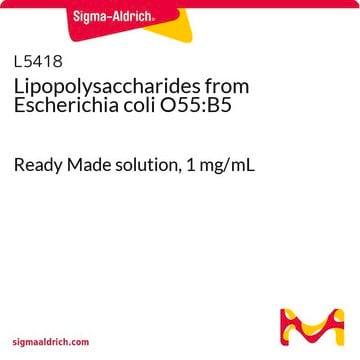L1887
Lipopolysaccharides from Salmonella enterica serotype abortus equi
purified by gel-filtration chromatography
Sinonimo/i:
LPS
About This Item
Prodotti consigliati
Origine biologica
Salmonella enterica (Serotype abortus equi)
Forma fisica
lyophilized powder
Purificato mediante
gel-filtration chromatography
Impurezze
<1% Protein
Condizioni di spedizione
ambient
Temperatura di conservazione
2-8°C
Cerchi prodotti simili? Visita Guida al confronto tra prodotti
Descrizione generale
Applicazioni
Azioni biochim/fisiol
Nota sulla preparazione
Sigma typically tests the solubility of FITC dextrans in water at concentrations at or above 25 mg/ml. Solutions should be protected from light. In vivo, FITC-dextran is stable for more than 24 hours.
Altre note
Prodotti correlati
Avvertenze
Danger
Indicazioni di pericolo
Consigli di prudenza
Classi di pericolo
Acute Tox. 2 Oral
Codice della classe di stoccaggio
6.1A - Combustible acute toxic Cat. 1 and 2 / very toxic hazardous materials
Classe di pericolosità dell'acqua (WGK)
WGK 3
Punto d’infiammabilità (°F)
Not applicable
Punto d’infiammabilità (°C)
Not applicable
Certificati d'analisi (COA)
Cerca il Certificati d'analisi (COA) digitando il numero di lotto/batch corrispondente. I numeri di lotto o di batch sono stampati sull'etichetta dei prodotti dopo la parola ‘Lotto’ o ‘Batch’.
Possiedi già questo prodotto?
I documenti relativi ai prodotti acquistati recentemente sono disponibili nell’Archivio dei documenti.
I clienti hanno visto anche
Contenuto correlato
Lipopolysaccharide (LPS) is a major component of Gram-negative bacteria, important for microbiological research.
Il team dei nostri ricercatori vanta grande esperienza in tutte le aree della ricerca quali Life Science, scienza dei materiali, sintesi chimica, cromatografia, discipline analitiche, ecc..
Contatta l'Assistenza Tecnica.




